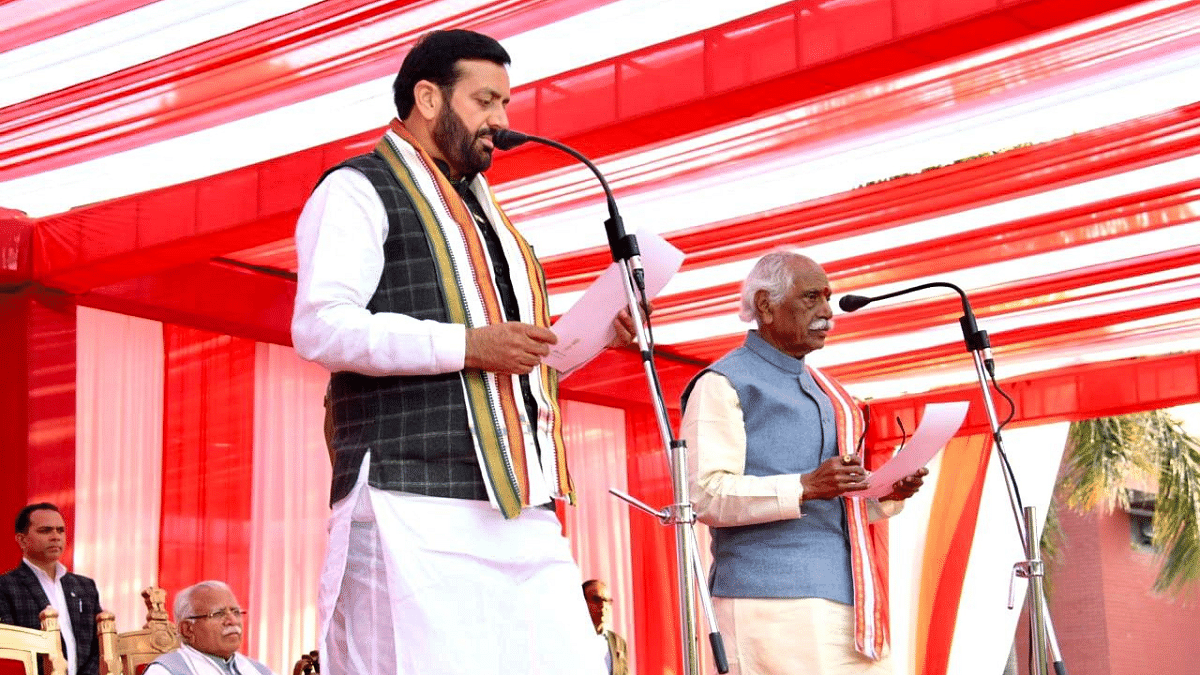Gurugram: Haryana saw Manohar Lal Khattar resign as chief minister on Tuesday morning followed by the BJP state chief Nayab Singh Saini getting the vote at a legislature party meeting after the party’s decision to end ties with Jannayak Janta Party (JJP) .
Political observers see this sudden move as an attempt to woo the Other Backward Class (OBC) communities, while the opposition Congress said that the BJP has already accepted defeat ahead of the Parliamentary and state elections.
Accompanied by Khattar, Saini left for the Raj Bhavan to stake a claim for forming the government. The Kurushetra MP took the oath of office and secrecy in the evening. Saini will have to enter the Haryana assembly as an MLA within six months, i.e.before 11 September, of becoming the chief minister.
Along with Saini, BJP MLAs Kanwar Pal Gujjar, Mool Chand Sharma, J.P. Dalal and Banwari Lal and Independent MLA Ranjit Singh Chautala were also administered the oath as ministers. All of them had served as ministers in the Khattar cabinet.
The legislature party meeting, which was held in the presence of central observers Arjun Munda and Tarun Chugh, saw its share of drama as well.
Senior BJP leader Anil Vij, a senior minister in the outgoing cabinet, left the meeting in a huff. Sanjay Bhatia, BJP MP from Karnal, came running after Vij, apparently to request him to return to the meeting. But, the latter parked the official car outside the Haryana Niwas and left in a private vehicle.
He left for his hometown Ambala from there and didn’t even attend the swearing-in ceremony.
According to Mahabir Jaglan, a political analyst from Haryana, the move to replace Khattar with Saini is also an attempt to stem the anti-incumbency wave of the two terms of the BJP government.
Jaglan added that the move might not help the BJP because Saini was not from the artisan classes of backward castes who were considered poor and socially backwards, but from the dominant agrarian castes such as Yadavs, Gujjars, Kamboj among others.
“Ever since Rahul Gandhi started demanding a caste census, the BJP became wary of the OBCs shifting towards the Congress. However, if the BJP government thinks that this will help in averting anti-incumbency, this is unlikely because the sections of the society like farmers who are unhappy with the BJP in Haryana are upset over the BJP’s policies and not merely against Khattar personally,” Jaglan explained.
Also Read: ‘No democracy within BJP’ — Hisar MP Brijendra, father Birender Singh go Congress way
OBC arithmetic
Though there is no authentic data of the caste-wise population in Haryana, various estimates put the population of backward classes at 35 percent. The Dalits and the general caste, including the Jats, comprise nearly 20 percent and 45 percent, respectively.
Unlike the Centre which collectively classifies castes that are educationally or socially backward as ‘OBCs’, Haryana refers to this category as ‘backward classes’ and sub-categorises them as BC-A and BC-B for reservation.
As many as 72 castes are included in the BC-A category in Haryana, according to the Directorate of Welfare of Scheduled Castes and Backward Classes.
Historically, these 72 castes were landless communities engaged in jobs of an artisan nature such as those making iron tools (Lohar), preparing earthen pitchers (Kumhar), melting and designing gold (Sunar), washing clothes (Dhobi), roasting grams and groundnuts (Bharbhunja), and extracting oil from oilseeds (Teli).
In contrast, those falling in Block B were relatively better placed and are more likely to own land. Yadav/Ahir Gujjar, Lodha, Saini, Meo, and Goswami fall in this sub-group.
Congress slams Khattar
Former CM Bhupinder Singh Hooda said that so far as the snapping of ties with the JJP was concerned, he “had said a week back that the BJP and the JJP had entered into a new agreement to divide opposition votes”.
But by changing the chief minister, the Congress leader said, the BJP has accepted its defeat.
“The BJP-JJP government led by Khattar failed on all fronts. People were unhappy and are waiting to oust this government in the assembly election this year. By changing the CM, the BJP has tried to cover up its failures by bringing in a new face, but this is not going to help,” said Hooda.
Congress general secretary Randeep Singh Surjewala, too, tweeted that the BJP enacted “a prearranged drama” of snapping ties with the JJP to save itself from the consequences of the failures and ineffectiveness of over nine years.
हरियाणा में पूर्व निर्धारित “स्क्रिप्ट” के आधार पर हरियाणवीयों को जाति के बिभाजन में बाँट वोट बटोरने की “राजनीतिक सर्कस” शुरू ।
▶️ साढ़े नौ साल की खट्टर सरकार की नाकामयाबी और नकारापन से बचने के लिए गठबंधन तोड़ने का ‘पूर्व निर्धारित ड्रामा’ । आधे अब भाजपा में और आधे जजपा में।
▶️…
— Randeep Singh Surjewala (@rssurjewala) March 12, 2024
Kumari Selja, another general secretary of the Congress, described the act of replacing Khattar with Saini as a “repackaging” to fool the voters.
Notwithstanding the circumstances, Saini’s rise in politics has been meteoric. He won his first assembly election from Narayangarh in Ambala in 2014. Two years on, he was inducted into the Khattar cabinet as a Minister of State.
In 2019, Saini contested successfully from the Kurukshetra parliamentary constituency. Considered close to Khattar, Saini replaced O.P. Dhankar as BJP state chief in October last year.
It was Khattar whose influence drew Saini to the Rashtriya Swayamsevak Sangh (RSS) during his student days.He was named district president of Bhartiya Janata Yuva Morcha in 2002. In 2012, he became the BJP district president of Ambala.
(Edited by Tony Rai)
Also Read: ‘Prefer NDA but prepared to go alone’ — JJP sets up panel to chart future of tie-up with BJP

